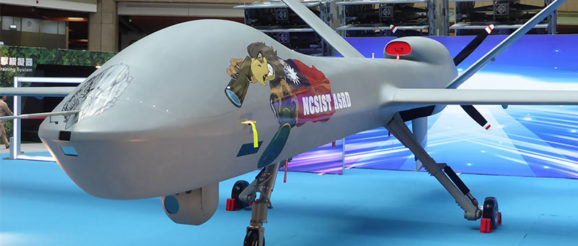Taiwan’s Defence Innovation on Show – Asian Military Review

This year Taiwan’s biennial defence show, the Taipei Aerospace & Defence Technology Exhibition (TADTE), was staged from 15-17 August in Taipei. Taiwan’s External Trade Development Council (TAITRA) invited Asian Military Review to review what was on show.
Two of the most striking exhibits at TADTE 2019, both of which took pride of place within the Ministry of National Defence (MND) Pavilion were the Taiwan National Chung-Shan Institute of Science & Technology (NCSIST) loitering anti-radiation munition and the full size mock-up of a medium-altitude long-range (MALE) unmanned aerial vehicle.
The Jian Hsiang anti-radiation loitering munition was displayed on its own and as part of a truck mounted battery which can carry up to 12 of the munitions in individual bays – one solution to keep them mobile and avoiding counter-attacks by hostile forces.
Jian Hsiang has a range of around 300km and can be fired from fixed launchers, the mobile battery or loaded onboard ships belonging to the Republic of China Navy (RoCN). Defence observers have noted a strong resemblance of the system to the Harpy loitering munition produced by Israel Aerospace Industries (IAI), although this was claimed to be coincidental.
NCSIST Taiwan’s main research and development agency responsible for developing technology and creating a national independent defence capability. it also develops critical technology and systems that can be integrated into future weapons development and production.
The MALE UAV on show was a beta updated version of the Teng Yun (Cloud Rider) UAV, the development of which was started by NCSIST in 2015. The current timeline will see the Teng Yun begin testing in January 2020 and will progress to full operational trials by 2021. The new version has an improved and enhanced flight control system and is capable of automatic take-off and landing using a turboprop engine, allowing it to carry a larger payload. During development, NCSIST’s aim was to enable the Teng Yun to have a 24 hour endurance capability with a range of over 1000km which would allow it to engage in long patrol missions, particularly in the maritime environment. It will carry a range of sensors that will include providing real-time video transmission.
In total the MND exhibited 81 different weapons systems and military hardware. including a prototype of the Cloud Leopard M armoured vehicle complete with 81mm mortar mounting.
Taiwan’s Defence Sector Grows
During the opening ceremony, James Huang, chairman, Taiwan External Trade Development Council (TAITRA), drew attention to the achievements of NCSIST and Aerospace Industrial Development Corporation (ADIC), highlighting “their latest instructional jet [for the military], which will help train even more top fighter jet pilots.” He added the achievement Taiwan’s National Space Organisation which, in June this year, “saw the successful launch of the Formosat-7 constellation, the biggest US-Taiwan scientific collaboration in 10 years.”
He also gave thanks to the participation in TATDE of international companies including Lockheed Martin, General Dynamics, BAE Systems, GE Aviation, and Thales. Other international defence companies did participate, usually on shared stands and keeping a low profile.
Jennifer Chuang, director, AIDC stated that her organisation supported both military and civilian aviation development. Within this, ADIC had supported the development of numerous programmes including the Xiong Ying (Taiwan Eagle), the Ching-Kuo (IDF) fighter, AT-3 and F5E/F.
The development of Taiwan’s Advanced Jet Trainer (AJT) is being conducted by the Aeronautical Systems Research Division within the NCSIST. The aim is to produce a subsonic jet trainer that will improve on legacy aircraft to better prepare pilots for the F-16 that they will ultimately fly. The AJT’s airframe has been redesigned to deliver a higher lift-to-drag ratio.
The big news that broke just after TADTE had closed was the announcement by the US State Defence Security Cooperation Agency (DSCA) that approval had been granted for an $8 billion Foreign Military Sale (FMS) of 66 Lockheed Martin F-16C/D Block 70 aircraft to Taiwan, something that the Republic of China Air Force (RoCAF) had sought for over a decade. The F-16 Block 70 represents the latest baseline model that combines Lockheed Martin’s Mid-Life Update (MLU) and Common Configuration Improvement Programme (CCIP) which will allow the F-16 fleet to be upgraded with technology insertion well into the future.
The complete package included 75 Block 70 F110 General Electric engines (one for each aircraft and nine spares); together with the same number of Link-16 Systems; Improved Programmable Display Generators (iPDG); APG-83 Active Electronically Scanned Array (AESA) Radars; Modular Mission Computers 7000AH; LN-260 Embedded GPS/INS; M61 Vulcan 20mm guns; as well as a wide variety of kinetic ordnance. During the show Lockheed Martin had been discreetly demonstrating its F-16V cockpit simulator to invited guests, including President Tsai Ing-wen.
Running at the same time as TADTE, the Taiwan International Drone Show (Drone Taiwan) attracted over 20 exhibiting companies, although most of the more serious models were aimed at the government emergency response market. One outstanding UAV was the three bladed Maritime Aerial Reconnaissance System (MARS) GRH-1 from Geosat. According to chairman and CEO, Dr Cheng-Fang Lo, the heavy fuel oil 100cc engine, fed by three fuel tanks, could allow the GRH-1 to fly at a cruise speed of up to 108km/h for over three hours with an EO/IR camera and optional laser sight. Likely customers would be the Taiwan Navy and Coastguard.

